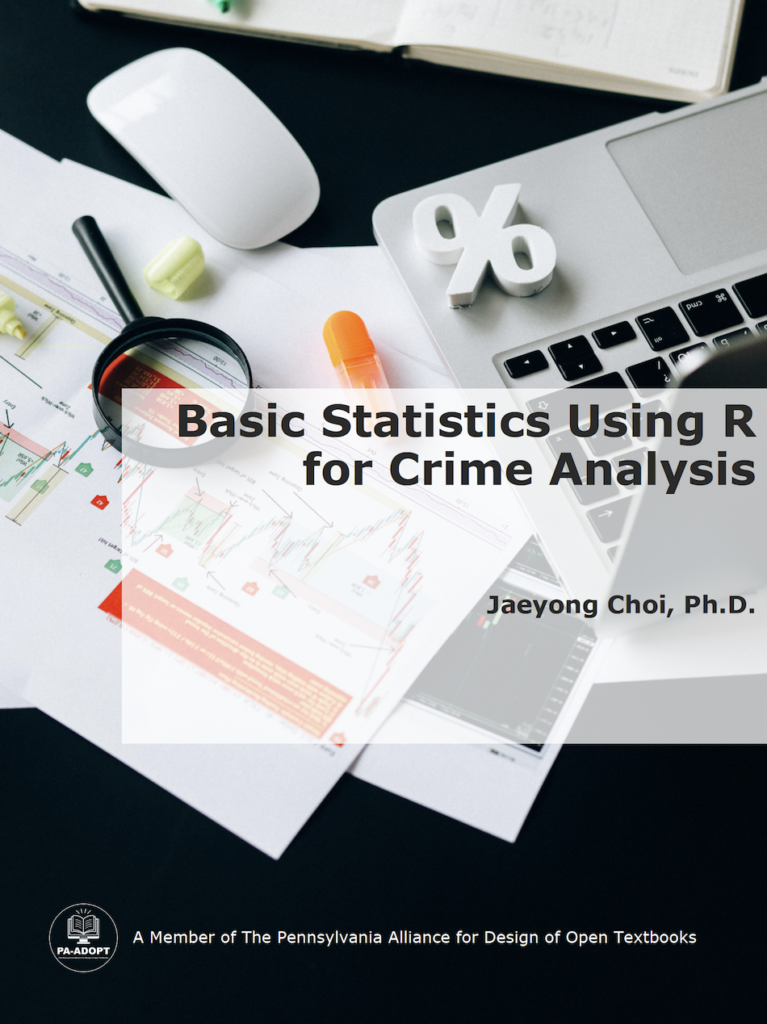Basic Statistics Using R for Crime Analysis
by Jaeyong Choi, Ph.D.
Keywords: Basic Statistics, Data Management, Analysis, R, Criminal Justice

About the Book
Limited access to subscription-based statistical software poses obstacles when students want to apply the skills they acquired in college. Although students may learn programs like SPSS or Stata while at the university, they often find themselves unable to continue using these programs after graduation, making their acquired skills obsolete. As an open-source software program, R offers a solution to this challenge. It is freely accessible to anyone, including students, after they graduate. Therefore, I decided to write a freely available book for those interested in becoming crime analysts, focusing on learning statistics without delving too deeply into mathematics. Moreover, this book emphasizes practical applications by utilizing R for data analysis, ensuring students can develop relevant skills beyond the university. I hope that students can easily follow the instructions in this book and replicate the same outcomes using the provided data. This practical experience will demonstrate the value of statistics and R, ideally inspiring students to further their learning in these areas.
Chapters
- Introduction to Crime Data Analysis, R and RStudio
- Introduction to Data Formations and Graphics
- Creating a New Variable and Producing Summary Statistics
- Central Tendency and Variability
- Reliability of a Scale
- Chi-Squared Test
- T-Test
- Analysis of Variance
- Correlation
- Linear Regression
General Information
- Publication Year: 2024
- Edition: First
- Subject: Statistics
- Latest File Update: December 2, 2025
License

This work is licensed under a Creative Commons Attribution-ShareAlike 4.0 International License (CC BY-SA 4.0) as a part of PA-ADOPT, except where otherwise noted.
Usage
Readers
The eTextbooks created as a part of this program are provided in two formats: ePub and PDF. Please refer to our Reader Support section for guidance on which format may be best for you and the device(s) you use.
Instructors
If you are an instructor seeking to use this eTextbook in your own course(s) please feel free to download the ePub and/or PDF file(s) for your use, but make sure to complete our eTextbook Usage Survey (this information is used for program evaluation purposes).
If you are interested in making revisions and edits to this eTextbook please note that this is possible since the book is under a Creative Commons License, which allows you to remix, reuse, revise, and redistribute the eTextbook. Please refer to the Faculty Support Page, specifically looking at Remixing. You can download Basic Statistics Using R for Crime Analysis Apple Pages File in order to use the original document to revise and remix the eTextbook for your purposes.
Citations
MLA: Choi, Jaeyong. Basic Statistics Using R for Crime Analysis. First, The Pennsylvania Alliance for Design of Open Textbooks (PA-ADOPT), 2024.
APA: Choi, J. (2024). Basic Statistics Using R for Crime Analysis. (First). The Pennsylvania Alliance for Design of Open Textbooks (PA-ADOPT).
Chicago: Choi, Jaeyong. Basic Statistics Using R for Crime Analysis. First. The Pennsylvania Alliance for Design of Open Textbooks (PA-ADOPT), 2024.
Peer Review
This eTextbook went through an Open Peer Review process. The peer review process used the Open SUNY Textbook Peer Review Guidelines, allowing peer reviewers to read the text carefully and evaluate the following:
- Educational Significance of Content including accuracy, appropriate and useful materials, valid and significant concepts, models, and skills, and key elements;
- Effectiveness as a Teaching Resource including a clear explanation of the concepts, alignment of materials to the learning process of the target audience, and alignment of the learning objectives with course goals; and
- Readability and Ease of Use including clarity and comprehensiveness, consistent writing style, readability and ease of use (logic, sequence, and flow), appropriateness for target readership level, and quality of Interactivity and multimedia learning objects.
As a part of the open peer review process, the public review conducted by Dr. Sungil Han is made available: Peer Review Document (PDF).